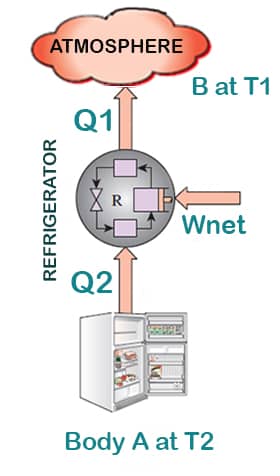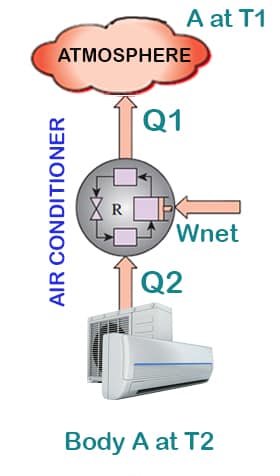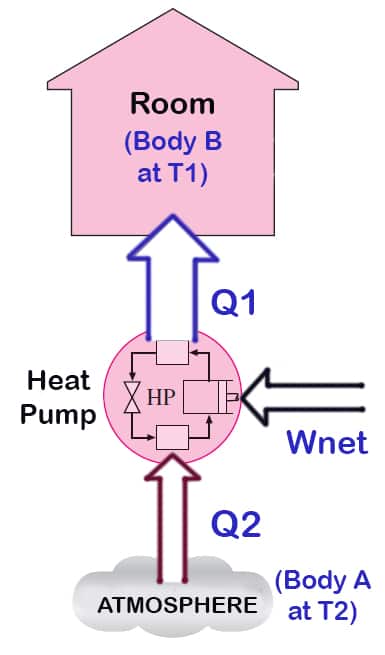The coefficient of performance is one of the main key factors for stating the efficiency of the air conditioning systems, refrigerators, or heat pumps. It is abbreviated as COP or CP or CoP. When you want to buy an air conditioner or refrigerator or a heat pump, the very first thing you have to check in the shop is to check the COP value. Let us explore, the details of COP!
What is Coefficient of Performance? Definition, Meaning, Formula
Definition of Coefficient of Performance
The coefficient of performance means the ratio of cooling output or heating output or the refrigerating effect to the work input.
- It means the ratio of refrigeration output to the compressor power input.
- COP increases mean refrigerating output is increased with respect to power input.
- COP increase means efficiency increases.
- It means COP increase means efficiency increase and COP reduces mean efficiency decreases.
- It implies the ratio of cooling output at the evaporator to the work input for the air conditioner or refrigerator.
- It also implies the ratio of heat extract value at the condenser to the work input for the heat pump.
- If COP is more, power consumption is more, and operating costs will be more.
Coefficient of Performance or COP Formula
We can write from the definition,
- COP = Refrigerant effect / Power input
- COP = Qc/Win,
This is known as the coefficient of performance formula, Where,
- QC – Refrigerant effect
- Win – Work input
We can do COP calculation based on the above COP formula.
COP Meaning
We have already understood that COP is the ratio of refrigerating effect to the power input. It is basically the amount of refrigerating effect per unit power input.
- An air conditioner has a COP value 5 means; 1 kW of power input is required to extract 5 kW of heat from the evaporator.
- A refrigerator has a COP value 4 means; 1 kW of power input is required to extract 4 kW of heat from the evaporator.
- A heat pump has a COP value 5 means; 1 kW of power input is required to release 5 kW of heat from the condenser.
- Sometimes, COP can be written as 3:1, instead of only 3, the meaning is the same, which is 3 units refrigerating effects produced by 1-unit power.
If the air conditioner has a cooling load of about 3.5 kW and the power input required is 0.75 kW. Hence, COP = 3.5 / 0.7, that means 5 times efficient than power consumption.
Units of COP
Since it is the ratio of the same kind of units, it doesn’t have any units. Will will try to understand the Coefficient of Performance of the refrigerator and the coefficient of performance of the heat pump.
Coefficient of Performance or COP of Refrigerator & Air Conditioner
We have already learned how does air conditioner works or the working principle of refrigerators. In these kinds of equipment, we can maintain a lower temperature than the atmospheric temperature. Let’s learn COP of both refrigerator and air conditioners with formula.
Coefficient of Performance or COP of Refrigerator
We all have refrigerators in our homes to keep vegetables or foodstuff cool or freeze for a couple of days. Here, a refrigeration cycle is inbuilt inside it and it removes the heat from inside the refrigerator. Let’s consider,
- A = Enclosed space or inside space of refrigerator or simply consider, as refrigerator body
- T2 = Temperature of the refrigerator
- B = Atmospheric space
- T1 = Atmospheric temperature

The heat from the room or atmosphere always tends to enter into the refrigerator. But, we know in the refrigerator, heat is not increased rather temperature is decreased and maintains a constant temperature (T2) at body A. Due to the refrigeration cycle in Refrigerator, it removes the heat from body A and maintains the constant temperature.
Let’s consider, Q2 is the amount of heat that is removed from refrigerator body A. It means this amount of heat (Q2) is absorbed by the working fluid in the refrigerator evaporator coil. Working fluid means refrigerant in the refrigerant cycle of the refrigerator. Here, the refrigerant is evaporated, and latent heat is taken from body A for evaporation. Rejected heat is Q1. We have already learned refrigeration cycles, Where,
- Evap. – Evaporator
- Comp. – Compressor
- Cond – Condenser
- Exp. – Expansion valve
To remove the heat, we have to start the compressor that means work should be done on the compressor. Let us consider, Wc = power input to the compressor. In the expansion valve, the expansion will happen, and consider ‘We’ is the power output.
Hence, the network is done on the system, Wnet = Wc-We.
- Q2 + Wc = Q1+ We
- Or, Wc – We = Q1-Q2
So, Coefficient of performance of refrigerator, COP = Refrigerant effect / Power input
- Or, COP = Q2 / Wnet
- Or, COP = Q2 / (Q1-Q2)
Coefficient of Performance or COP of Air Conditioner
An enclosed space is having an air conditioner and it cools the space.
- A = enclosed space or room which is conditioned, or body you can say, for considering the purpose
- T2 = temperature of the conditioned space
- B = atmospheric space
- T1 = atmospheric temperature

The heat from the surroundings or heat from the equipment kept inside body A, always tends to increase the temperature. Now, how do we maintain the constant temperature (T2) at body A? It is by done air conditioners. The air conditioner removes the heat from body A and maintains the constant temperature.
Let’s consider, Q2 is the amount of heat that is removed from body A by the air conditioner. It means this amount of heat (Q2) is absorbed by the working fluid in the evaporator coil of the air conditioner. Here, the refrigerant is evaporated, and latent heat is taken from body A for evaporation. Rejected heat is Q1. We have already learned refrigeration cycles, Where,
- Evap. – Evaporator
- Comp. – Compressor
- Cond – Condenser
- Exp. – Expansion valve
To remove the heat, we have to start the compressor that means work should be done on the compressor. Let us consider, Wc = power input to the compressor. In the expansion valve, the expansion will happen, and consider ‘We’ is the power output. Hence, the network is done on the system,
Wnet = Wc-We.
- Q2 + Wc = Q1+ We
- Or, Wc – We = Q1-Q2
So, the Coefficient of performance of refrigerator, COP = Refrigerant effect / Power input
- Or, COP = Q2 / Wnet
- Or, COP = Q2 / (Q1-Q2)
Coefficient of Performance or COP of Heat Pump
We have already learned how do heat pumps work or the working principle of a heat pump. In this type of equipment, we maintain a higher temperature of the inside room temperature than the outside temperature. Let’s consider, an enclosed space is having a heat pump and it heats the space.
- B = a body or an enclosed space
- T1 = temperature of the enclosed space
- A = atmospheric space
- T2 = atmospheric temperature

The temperature of the enclosed space (T1) is required to make higher than the atmospheric temperature (T2). Now, how to maintain the higher temperature (T1) at body B? It can be done by heat pumps. Heat pumps take the heat from the atmosphere and supply it to body B and maintain a constant temperature.
Let’s consider, Q2 is the amount of heat that is removed from the atmosphere by the heat pump. It means this amount of heat (Q2) is absorbed by the heat pump. Q1 is the heat supplied to body B to maintain a constant temperature. Rejected heat is Q1. We have already learned refrigeration cycles, Let us consider,
- Wc = power input to the compressor.
- We = the power output.
Hence, the network is done on the system, Wnet = Wc-We
- Q2 + Wc = Q1+ We
- Or, Wc – We = Q1-Q2
So, the Coefficient of performance of heat pump, COP = Refrigerant effect / Power input
- Or, COP = Q1 / Wnet
- Or, COP = Q1 / (Q1-Q2)
Relationship between COP of Heat Pump and COP of Refrigerator
We have derived the CPs of heat pumps and refrigerators.
- COPr = COP of Refrigerator
- COPhp = COP of heat Pump
- COPr = Q2 / (Q1-Q2)
- COPhp = Q1 / (Q1-Q2)
- COPhp – COPr = 1
- COPhp = 1 + COPr
From the above formula, we can write,
COP of Heat Pump = 1 + COP of the Refrigerator
How to Improve the Coefficient of Performance?
Flash Chamber & Accumulator
- The main problem for the reduction in efficiency of the refrigeration cycle is the expansion or throttling process in the expansion valve.
- It reduces cooling capacity as well as increase the power input.
In the case of the expansion process in the expansion valve, some amount of refrigerant vapor is generated due to low pressure. These vapors will not be able to take the heat from the adjacent air. It cannot take part in any action in the evaporator. Hence, a flash chamber between the expansion valve and evaporator can be placed to avert this problem.
- Vapor will directly go to the compressor
- The liquid will go to the evaporator
- Increase the efficiency of the evaporator
- Increase the volume of liquid in the evaporator
- Increase the COP by all the modifications.
- This can also be done by using an accumulator where liquid refrigerant and vapor are separated by a baffle plate.
Remember if the load is fixed it is better to use the flash chamber and if the load varies, it is better to use an accumulator.
Single Stage Cycles Improvement
- To increase the single-stage cycle efficiency, a vortex tube is used. This tube is known as the Ranque Hilsch vortex tube.
- It is placed between the expansion valve & evaporator.
- After expansion, the liquid refrigerant will have unwanted refrigerant vapor.
- The liquid refrigerant is circulated from the expansion valve.
- The vortex tube divides the flow into the two-part, hot flow, and cold flow.
- The cold vapor goes to the evaporator & cools before the evaporator.
- The hot vapor cools in the tube and passes to the evaporator.
- Increase efficiency as well as COP.
Subcooling of Liquid Refrigerant by Refrigerant Vapor
- Heat exchanger is placed between the condenser and the expansion valve.
- Refrigerant vapor is used in this method.
- The heat exchanger is having two streams, (1) High-temperature liquid which normally flows from the condenser to the expansion valve (2) Low-temperature vapor
- Heat exchange happens between high-temperature liquid and low-temperature vapor.
- High-temperature liquid releases heat and sub-cooling happens.
- COP is increased.
Other processes to increase efficiency, which improve COP,
- Keeping outdoor units in a shade instead of direct sunlight. It increases the efficiency & COP of the system.
- Use an efficient compressor, digital scroll compressor is the best choice for small-scale applications.
- The evaporator filter should be cleaned.
- The condenser should be cleaned.
- The exhaust flow path from the condenser should not be obstructed.
- Selecting proper material of evaporator and condenser coil. Copper is the best choice.
- Using good refrigerant which has good efficiency.
- Using heat pipes, a heat exchanger, used in the air conditioning system, can help to increase efficiency.
- Absorption chiller’s COP can be improved, if the numbers of stages are possible to increase.
- Using Nano-refrigerant can increase efficiency.
- In a chilled water system, the power consumption of pumps can be reduced by selecting high-efficiency pumps.
Calculation of Coefficient of Performance or COP
Let us consider, a heat pump is running in your room. Coefficient of performance, COP = 3, the compressor power consumption is 1800 watts. Now, we will calculate, Q1, the heat which is to be added to the room.
COP if it cools the room.
Explanation & Solution
- COP = Q1 / Wnet
- 3 = Q1 / 1500,
- Q1 = 4500 kW
In case of the cooling mode,
- Wnet = Q1-Q2
- Q2 = 4500-1500
- Q2 = 3000 kW
- COPcold = 3000/1500 = 2.0
Why there are 2 different COPs for heating?
The COP is based on the temperature difference between indoor temperature and outdoor temperature. Any changes in these data, COP will be different and it is possible to have many different data and many COPs. However, for the ease of calculation as well as equipment selection, we consider two separate outdoor temperatures,
- At hot session
- At winter session
Based on the above, two different COPs are calculated.
Advantage of Coefficient of Performance
- It is widely used for small capacity air conditioners, heat pumps, and refrigerators
- With the COP, the efficiency of equipment is easily known, power consumption as well as the electrical cost to be known.
- Equipment selection is done based on COP.
Limitation of Coefficient of Performance
- COP is normally used in heat pumps and small capacity air conditioners and refrigerators.
- All other systems, there are various efficiency ratings like EER, SEER, etc. widely used.
FAQs for COP
How do you calculate coefficient of performance?
The coefficient of performance means the ratio of cooling output or heating output or the refrigerating effect to the work input.
COP = Refrigerant effect / Power input
Conclusion
We have learned the basics of the coefficient of performance, COP along with a few calculations. If you have any suggestions, please write to us. Anyways, do you want to check your learning from this article?

Hello, I am a huge fan of your blog! I really agree with your point as I am currently employed as an autocad operator for a BPO provider.
Thank you so much for visiting us, appreciate